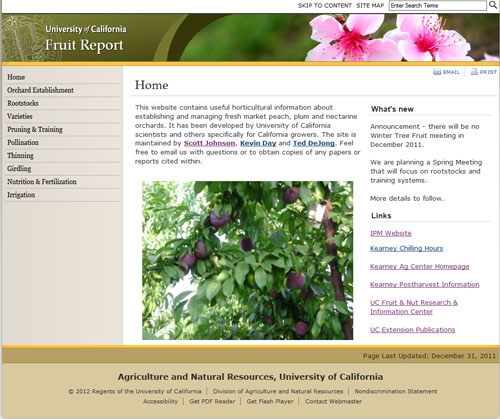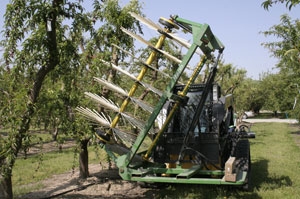Posts Tagged: Scott Johnson
New “UC Fruit Report” launched
A newly redesigned website, the UC Fruit Report, was launched at the beginning of 2012 with comprehensive information for Central Valley tree fruit producers. The website contains research and photos that three UC Cooperative Extension advisors and specialists developed and collected over the past 30 years.
Website visitors will find useful horticultural information about establishing and managing fresh market peach, plum and nectarine orchards. UC pomology specialist Scott Johnson, who is based at the Kearney Agricultural Research and Extension Center, devoted half of his year-long sabbatical in 2011 to aggregating the information online.
“The website has a lot of information that will help farmers,” Johnson said. “If they’re seeing symptoms on their leaves that they think is a nutrient deficiency, they can go into the site and look at pictures and compare. If they’re planning future orchards, they can go through 35 different rootstocks, from dwarfing rootstocks to those that are resistant to certain diseases.”
The basic information on the website is concise and easy to read. The entries include links to detailed research reports for those who wish to explore the topics further.
The site is maintained by Johnson, Tulare County UCCE farm advisor Kevin Day and UC Davis-based pomology specialist Ted De Jong. They will periodically update the website to reflect the newest research findings and post timely news.
“For example, if we’re seeing a problem with mites,” Johnson said. “We can put that up on the web, where farmers can find solutions to the problem.”
Separate sections in the website are devoted to:
- Orchard establishment
- Rootstocks
- Varieties
- Pruning and training
- Pollination
- Thinning
- Girdling
- Nutrition and fertilization
- Irrigation

The new UC Fruit Report website contains information collected over 30 years.
An experimental fruit thinner studied at Kearney

UC researchers are experimenting with a variety of methods that will help farmers reduce the cost of fruit thinning. Peach, nectarine, plum and apple trees typically set a tremendous amount of fruit. The fruit must be thinned considerably to ensure adequate fruit size.
Since employing farmworkers for hand thinning is a major expense for farmers, researchers have been looking for a mechanical alternative.
One such machine being tested this spring is a “drum shaker,” which was recently shipped to the Kearney Agricultural Research and Extension Center from the USDA Agricultural Research Service’s Appalachian Fruit Research Station in West Virginia.
“We took the drum shaker out to several orchards,” said UC staff research associate Becky Phene, who works in collaboration with UC pomology specialist Scott Johnson. “In four locations, we tagged and labeled shoots, then ran the drum shaker through those rows.”
The researchers counted the fruit on the shoots before and after the drum shaker treatment.
“Our findings show a modest removal of fruit at 350 to 400 rpm,” Phene said.
The experiments have shown that a number of factors come into play when using the mechanical thinning device, such as tree structure, age and fruit size.
“The larger, sturdier scaffolds are harder to shake and suffer more shoot damage or shoot removal,” she said. “The younger, more flexible scaffolds appear more capable of reverberating the energy out to more shoots and shake off more fruit. Also, larger fruit tend to have a better removal rate.”